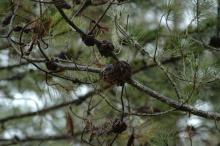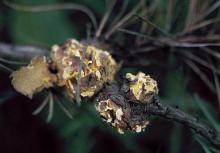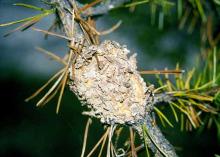Cause Endocronartium harknessii (formerly Peridermium harknessii), a fungus. The disease is commonly found on the hard pines, particularly those with two needles in the fascicle. Shore pine (Pinus contorta), lodgepole pine (P. contorta var. latifolia), mugo pine (P. mugo), Scots pine (P. sylvestris), and Austrian pine (P. nigra), appear particularly susceptible. Ponderosa pine (P. ponderosa) does not appear particularly susceptible. This is one of the most common diseases of shore pine yet can be very patchy in distribution.
Unlike white pine blister rust, western gall rust does not require an alternate host to complete its life cycle. Spores produced on pine can reinfect susceptible pines. Spores are shed primarily during shoot elongation. Shoots are susceptible from budbreak through shoot elongation. In the natural landscape, the disease is most commonly found in riparian areas or locations where moist air collects.
Symptoms Rough, globular galls on trunk or branches. Galls are proportionate in size to the branches bearing them. When the fungus is fruiting (aecia), galls are orange or yellow. Galls may kill small trees but increase in size for many years on larger trees. Trees may break easily at the gall.
Cultural control
- Remove trees with galls within 300 yards of nurseries.
- In nurseries, remove all affected trees.
- Forest-cull heavily infected trees.
- Remove galls whenever practical.
- Favor uninfected or lightly infected trees during thinning or seed collection.
Chemical control Needed only for landscape trees or Christmas trees. Protect new shoots from budbreak through shoot elongation.
- Preventive fungicide applications. Based on a single trial in California with Monterey pine, triadimefon (Group 3 fungicide) provided 7 days of protection and about 2 weeks of kickback activity. Disease control averaged 70%.
- Armada 50 WDG at 9 oz/100 gal water. Do not use a silicone-based surfactant. Not for nursery or greenhouse use. Group 3 + 11 fungicide. 12-hr reentry.
- Dithane M45 at 2 to 4 lb/A or per 100 gal water plus a spreader-sticker. Effective for Scots pine. Registered for use on Christmas trees. Group M3 fungicide. 14-day PHI. 24-hr reentry.
- Penncozeb 75 DF at 2 to 4 lb/A. Registered for use on Christmas trees. Group M3 fungicide. 24-hr reentry.
- Gallex (ready to use) painted on very young galls to reduce further development. Galls may return the following year or, if treated late, may continue to develop. Tissue surrounding the gall may be injured especially on younger plants. Prepare the surface by removing debris from around the galled area. Allow drying before application. Registered for use in Oregon and Washington but not registered in Idaho. 24-hr reentry.
Reference Moltzan, B.D., Blenis, P.V., and Hiratsuka, Y. 2001. Effects of spore availability, spore germinability, and shoot susceptibility on gall rust infections of pine. Plant Disease 85:1193-1199.




